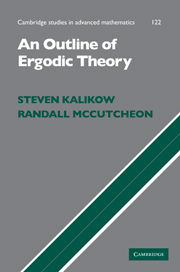2 - Measure-preserving systems, stationary processes
Published online by Cambridge University Press: 05 June 2012
Summary
Systems and homomorphisms
In this subchapter, we give basic definitions concerning measure-preserving systems and homomorphisms between them.
127. Definition. Let (Ω, A, μ) be a probability space and assume that T: Ω → Ω is a measure-preserving transformation. We call the quadruple (Ω, A, μ, T) a measure-preserving system. If there are sets X, X′ ∊ A of full measure such that T is a bimeasurable bijection between X and X′ then we say that the system (Ω, A, μ, T) is invertible, or simply that T is invertible.
128. Comment. Whereas probability theory is the study of probability spaces, ergodic theory is the study of measure-preserving systems. In other words, the most basic object of study for a probabilist is (Ω, A, μ), while the most basic object of study for an ergodic theorist is (Ω, A, μ, T).
129. Convention. In this book we will primarily deal with invertible measure-preserving systems. Accordingly, we may not always say “invertible” though we generally mean it unless we specify otherwise.
130. Definition. Let (Ω, A, μ, T) and (Ω′, A′, μ′, T′) be measure-preserving systems and assume that π: Ω → Ω′ is a measure-preserving transformation such that T′πω = πTω for a.e. ω ∈ Ω. Then we call π a homomorphism. We also say that the system (Ω′, A′, μ′, T′) is a factor of the system (Ω, A, μ, T), and that the system (Ω, A, μ, T) is an extension of the system (Ω′, A′, μ′, T′).
Information
- Type
- Chapter
- Information
- An Outline of Ergodic Theory , pp. 26 - 54Publisher: Cambridge University PressPrint publication year: 2010
